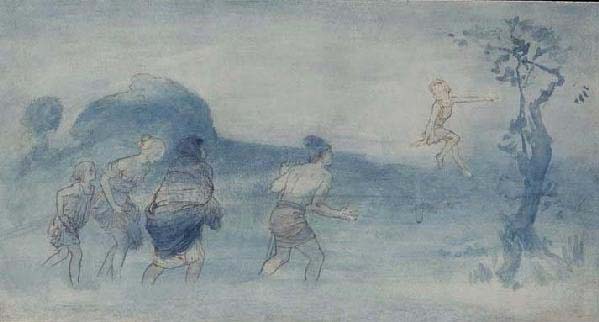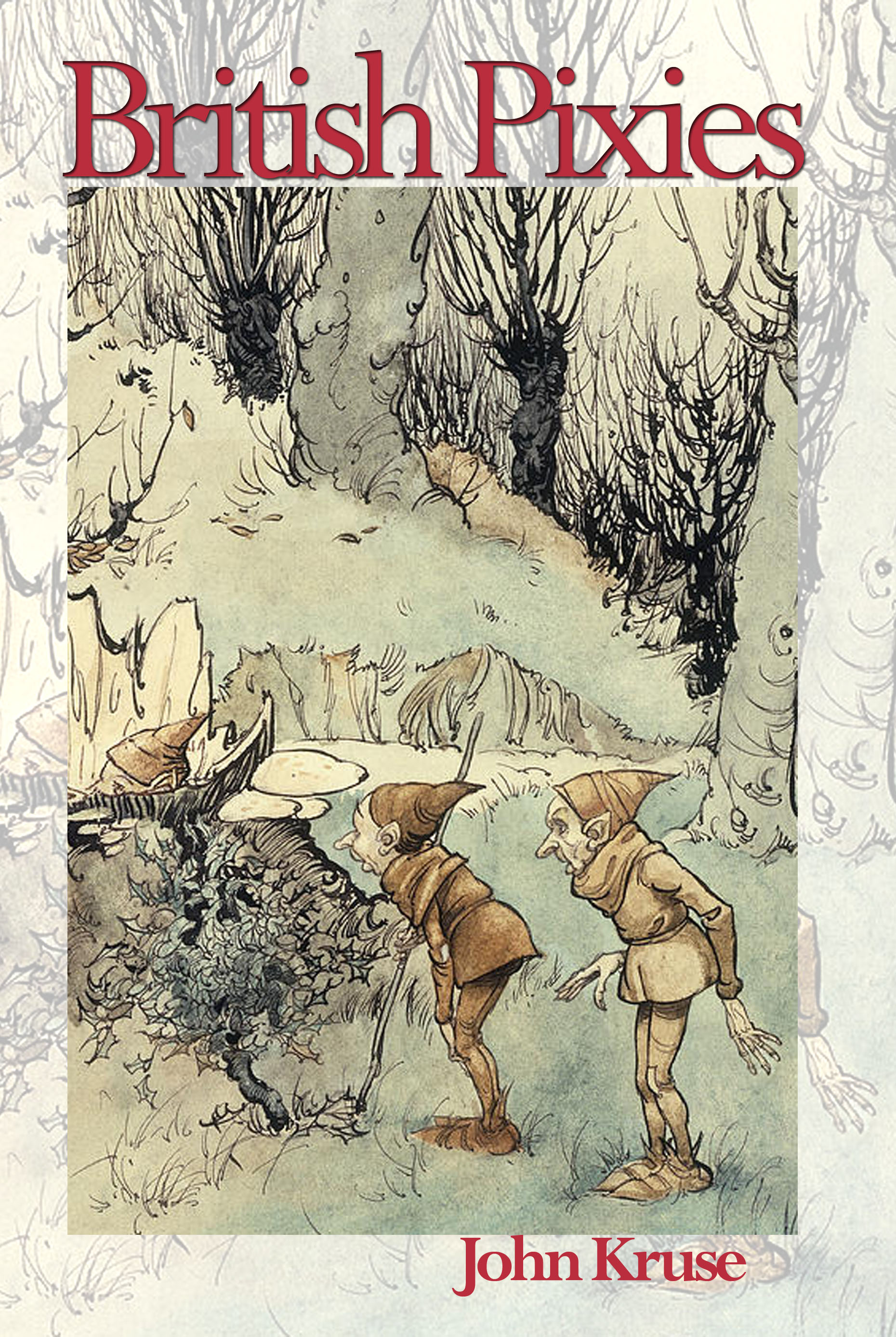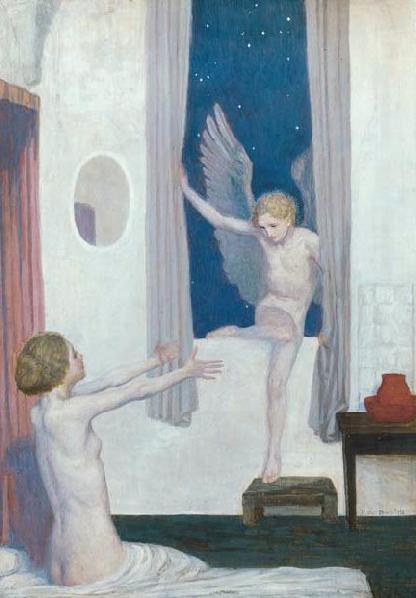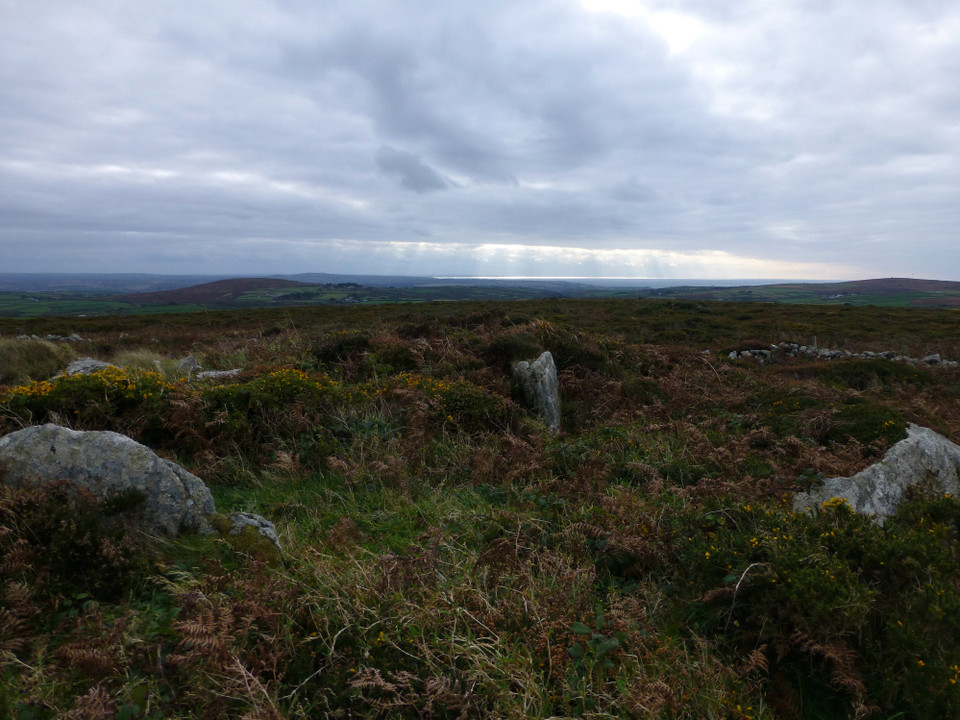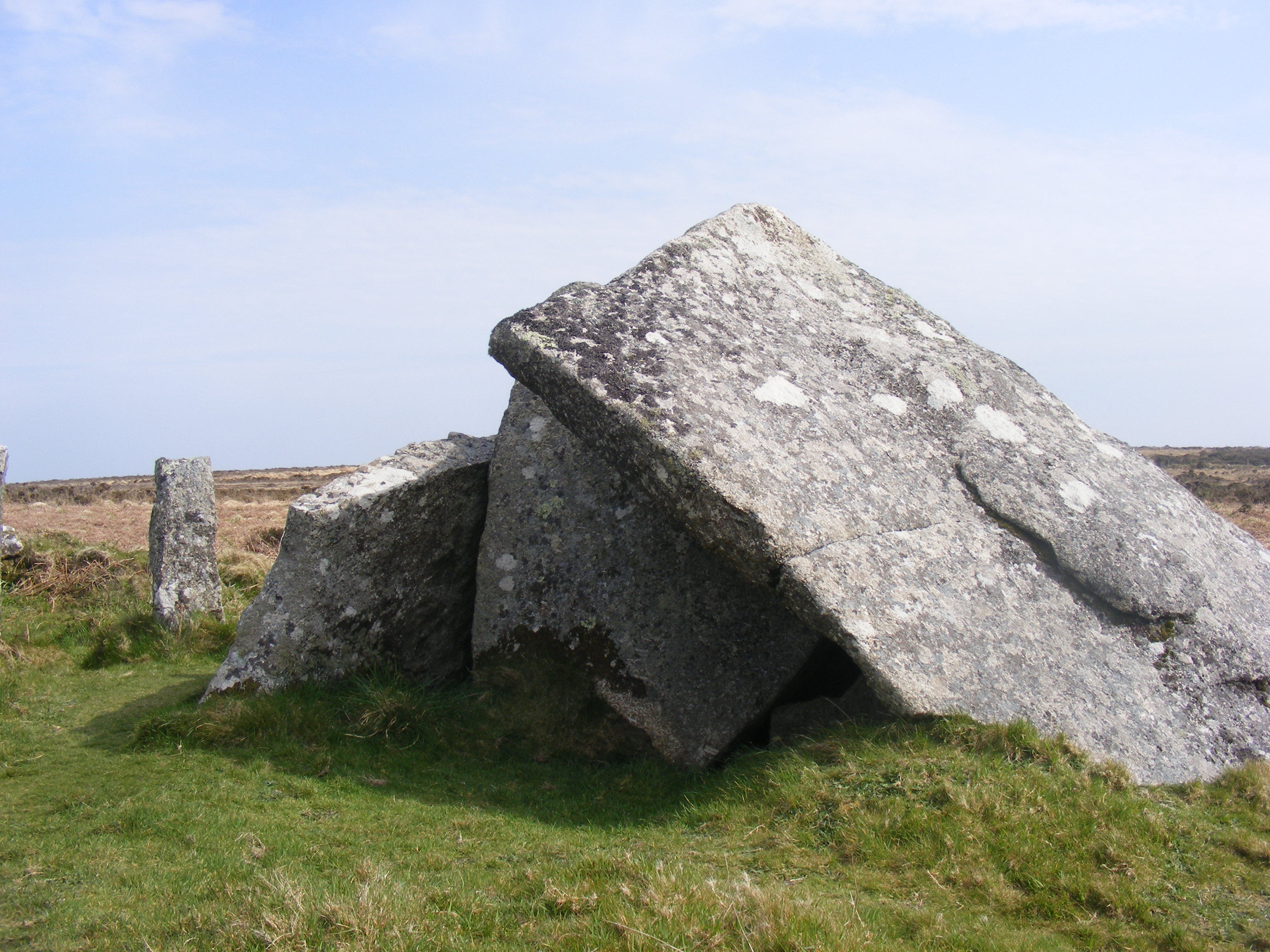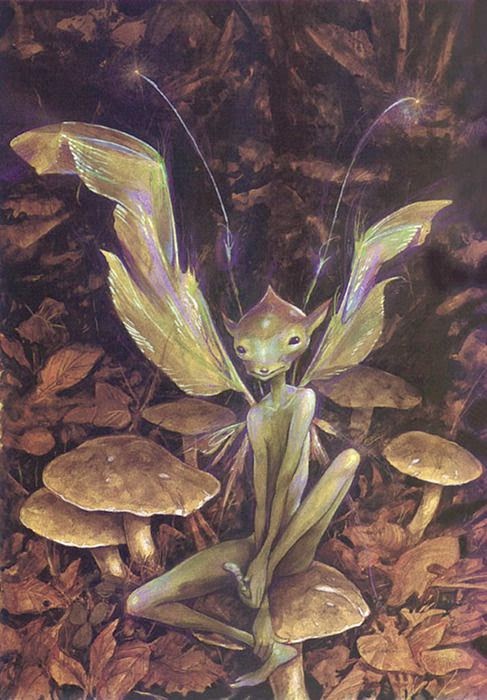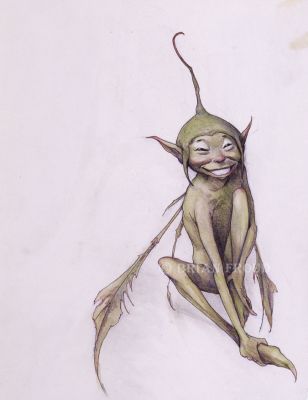
A view west towards Silena Moor (in the valley) today
Here is an annotated version of this fascinating text, taken from William Bottrell’s Traditions and Hearthside Stories of West Cornwall, Second Series, Penzance 1873, pp.94-102
“When the ancient family of Noy flourished in Buryan, there was a large tract of unenclosed common, belonging to the farms of Pendrea, Selena, and Tresidder, which extended from Cotnewilly to Burnewhall, and branched off in other directions. Great part of this ground was swampy and produced a rank growth of rushes, water-flags, and coarse herbage. Many acres were gay in summer with cotton-grass, bog-beans, cucco-flowers, and other plants usually found in such soil. In some places were dry rocky banks overgrown with sloe-trees, moor-withey, furze, and brambles; these patches being surrounded by a broad extent of quaking bog or muddy soil appeared like islands in a marsh. There were also many springs, rivulets, and pools, that seldom froze, much frequented by wild-fowl in winter. Great part of this moorland was then impassable; horse-tracks leading to Burnewhall, Selena, and other farms, passed over the driest places, and were continued by rough causeways through swamps;—they were very bad roads at all seasons.
[Silena Moor is still to be found in Penwith, to the west of Newlyn on the main B3315 road to Land’s End. It is to the south west of St Buryan and is an area of rough grass and scrub, as can just about be seen in the above photo.]
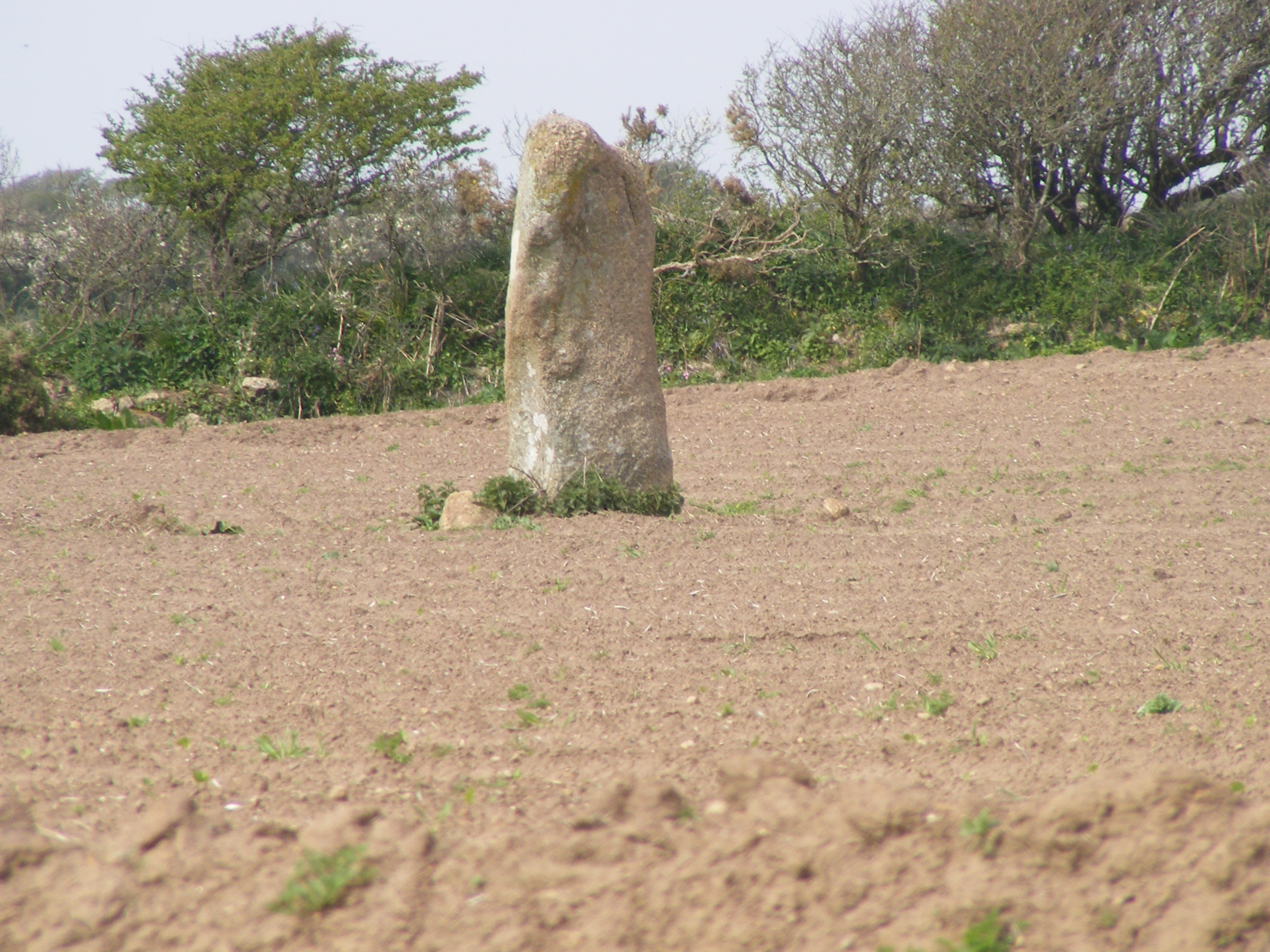
The menhir overlooking Silena moor
“One afternoon in harvest, Mr. Noy, with some of his men, were over to Burnewhall helping his kinsfolk, the Pendars. As more hands were required for the next day, which was to be the gulthise (harvest home), soon after ‘croust‘ time (lunch time) he rode up to Church-town to get them…
Soon after ‘day-down’ Mr. Noy, followed by his dogs, left the public-house intending to return to Burnewhall, but he didn’t arrive there that night nor the next. The Pendars and their people thought he might have enjoyed himself at the Ship Inn till late, and then have gone home to Pendrea. Mr. Noy had no wife nor anybody else to be much alarmed about him, as he was a middle-aged or rather elderly bachelor. But next day when people from Church-town, Pendrea, and scores of neighbours from other farms, came with their horses to help and to feast at the gulthise, and nobody among them had seen or heard of Mr. Noy from the time he left the inn, they got somewhat uneasy; … Dame Pendar sent messengers round to all places where she thought Mr. Noy might have gone, and they returned, just as the feast was breaking up, without any tidings of him.
Then everyone became anxious, and as it was near daybreak they volunteered to disperse and search in every place they could think of before going to bed. So away they went, some on horseback, others afoot, to examine mill-pools, stream-works, cliffs, and other dangerous places, near and far away. They returned at night, but nobody had seen or heard of the missing gentleman. Next morning horsemen were dispatched to other parishes, and as Mr. Noy was well known and liked there was a general turn out to hunt for him; but this day, too, was passed in a like fruitless search miles away.
On the third day, however, in the grey of the morning, a horse was heard to neigh, and dogs were heard barking among thickets on a piece of dry ground almost surrounded with bogs and pools, on Pendrea side of Selena Moor. Now it happened that no one had thought of looking for Mr. Noy in this place so near home, but when with much ado, a score or so of men discovered a passable road into this sort of island in the bogs, there they saw Mr. Noy’s horse and hounds; the horse had found plenty of pasture there, but the dogs, poor things, were half-starved. Horse and dogs showed their joy, and led the way through thorns, furze, and brambles—that might have grown there hundreds of years—till they came to large ‘skaw’ [elder] trees and the ruins of an old bowjey [cowshed] or some such building that no one knew of.
[Note the presence of fairy elder trees at the remote spot where Noy is found. The description of the spot as an ‘island’ may have resonances with the wider Celtic concept of faery as a normally inaccessible island in the sea]
“The horse stopped at what had been a doorway, looked around and whinnied; the dogs, followed by several people, pushed through the brambles that choked the entrance, and within they found Mr. Noy lying on the ground fast asleep. It was a difficult matter to arouse him; at last he awoke, stretched himself, rubbed his eyes, and said,
‘Why you are Burnewhall and Pendrea folks; however are ye all come here? To-day is to be the gulthise, and I am miles and miles away from home. What parish am I in? How could ‘e have found me? Have my dogs been home and brought ‘e here?’
Mr. Noy seemed like one dazed as we say, and all benumbed as stiff as a stake, so without staying to answer his questions, they gave him some brandy, lifted him on horseback, and left his steed to pick its way out, which it did readily enough, and a shorter one than they discovered.
[Note his physical and mental state– a good indicator of his recent contact with faerie. Waking up in a strange place after a fairy encounter is a very common scene, especially to be found in Welsh stories of visits to unknown houses and inns on the moors.]
“Though told he was on his own ground, and less than half a mile from Burnewhall, he couldn’t make out the country as he said, till he crossed the running water that divides the farms. “But I am glad,” said he “however it came to pass, to have got back in time for the gulthise.” When they told him how the corn was all carried three days ago, he said they were joking, and wouldn’t believe it till he had seen all in the mowhay [barn] under thatch and roped down; that the loose straw was raked up, and all harvest implements put away till next season.”
[We have the classic lapse of time here, something that typifies the difference between Faery and the human world. The mention of crossing streams may also be an indicator of a transition from faery back to the normal world.]
“Then whilst breakfast was getting ready, seated on a chimney-stool by a blazing fire, he told his neighbours that when he came to Cotnewilly, the night being clear, he thought he might as well make a short cut across the moor and save nearly a mile- as he had often done before in summer time- instead of going round by the stony bridle-path; but his horse, that was pretty much used to finding his own way when his master was tipsy, wanted to keep the usual road, and his rider, to baulk him, pulled farther off towards Pendrea side of the common than he would otherwise have done, and went on till he found himself in a part that was unknown to him; though he had been, as he thought, over every inch of it that man or beast could tread on, both in winter and summer. Getting alarmed at the strange appearance of everything around him, he tried in vain to retrace his steps, then gave the horse its head, and let it take its own course.
[This stumbling into a strange place in a familiar landscape is a very good example of the experience of being ‘pixy-led’.]
“Yet, instead of proceeding homeward, as was dobbin’s wont, it bore Mr. Noy to a land so crowded with trees that he had to alight and lead his steed. After wandering miles and miles, sometimes riding but oftener afoot, without seeing any habitation in this strange place, which he believed must be out of Buryan but in what parish he couldn’t tell, he at last heard strains of lively music, and spied lights glimmering through the trees and people moving about, which made him hope that he had arrived at some farm where they had a gulthise, and the harvest-folks were out, after supper, dancing in the town-place.
[Pretty obviously, Noy has crossed now into fairyland. This music and feasting is either some fairy event he has stumbled upon or is deliberately set up to lure him to them.]
“His dogs slunk back, and the horse wasn’t willing to go on, so he tied him to a tree, took his course through an orchard towards the lights, and came to a meadow where he saw hundreds of people, some seated at tables eating and drinking with great enjoyment apparently, and others dancing reels to the music of a crowd or tambourine—they are much the same thing—this was played by a damsel dressed in white, who stood on a heaping-stock just beside the house door, which was only a few paces from him.”
[The white dress may be indicative of fairy nature- and of course the reluctance of the dogs and horse to approach demonstrates their keener sense of otherworldliness- but then, they’ve not been in the Star Inn for several hours and they’re a good deal more alert than Mr Noy probably is as he comes upon this faery celebration. Across Britain, the faeries are renowned for their love of feasting, music and dance, all of which are good ways of trapping unwary humans too.]
“The revellers, farther off, were all very smartly decked out, but they seemed to him, at least most of them, to be a set of undersized mortals; yet the forms and tables, with the drinking-vessels on them, were all in proportion to the little people. The dancers moved so fast that he couldn’t count the number of those that footed jigs and reels together, it almost made his head giddy only to look at their quick and intricate whirling movements.”
[We’re dealing here with pixies or ‘an pobel vean’ the little people of Cornwall. As in many British stories, this is an encounter with small faeries– child height or less.]
“Noy noticed that the damsel who played the music was more like ordinary folks for stature, and he took her to be the master’s daughter, as, when one dance was ended, she gave the crowd to a little old fellow that stood near her, entered the house, fetched therefrom a black-jack [a leather jug], went round the tables and filled the cups and tankards that those seated, and others, handed to be replenished. Then, whilst she beat up a new tune for another set of dancers, Mr. Noy thought she cast a side-glance towards him; the music, he said, was so charming and lively that to save his soul he couldn’t refrain from going to join the dancers in a three-handed reel, but the girl with a frown and look of alarm, made a motion with her head for him to withdraw round a corner of the house out of sight. He remained gazing, however, and still advancing till she beckoned to the same little old man, to whom she spoke a few words, gave him the crowd to play, and leaving the company, went towards the orchard signalling to Mr. Noy to follow her, which he did. When out of the candle-glare and in a clear spot where moonlight shone, she waited for him. He approached and was surprised to see that the damsel was no other than a farmer’s daughter of Selena, one Grace Hutchens, who had been his sweetheart for a long while, until she died, three or four years ago; at least he had mourned her as dead, and she had been buried in St. Buryan Churchyard as such.”
[Grace is a fairy captive, a servant at the celebration rather than a participant. She knows the danger of Noy joining in the dance, which is a classic way of being ‘taken.’]
“When Mr. Noy came within a yard or so, turning towards him, she said, ‘thank the stars, my dear William, that I was on the look-out to stop ye, or you would this minute be changed into the small people’s state like I am- woe is me.’ He was about to kiss her, ‘Oh, beware!” she exclaimed, “embrace me not, nor touch flower nor fruit; for eating a tempting plum in this enchanted orchard was my undoing. You may think it strange, yet it was all through my love for you that I am come to this.'”
[‘Changed into the fairy state‘ is a very important phrase. Long presence in faery, and especially consumption of food and drink there, will alter you both physically and mentally. It’s interesting in this account that even touching one of the inhabitants can have the same effect.]
“‘People believed, and so it seemed, that I was found on the moor dead; it was also supposed that I must have dropped there in a trance, as I was subject to it. What was buried for me, however, was only a changeling, or sham body, never mine I should think, for it seems to me that I feel much the same still as when I lived to be your sweetheart.'”
[Abduction of people and livestock by a faked death, and the leaving behind of a ‘stock’ is a strategy used across Britain by the fays. A log or plant stem might be used for people, or a slaughtered cow’s hide might be stuffed- or even left behind with an elderly elf hidden within.]
“As she said this several little voices squeaked, “Grace, Grace, bring us more beer and cider, be quick!”
[Note the small voices to go with the small bodies of the pobel vean- and their treatment of Grace as a slave.]
“‘Follow me into the garden, and remain there behind the house; be sure you keep out of sight, and don’t for your life, touch fruit or flower,’ said she, in conducting out Mr. Noy, who desired her to bring him a tankard of cider too. ‘No, my love, not for the world,’ she replied, ‘await me here, I’ll soon return. Sad is my lot to be stolen from the living and made housekeeper to these sprites,’ murmured Grace, in quitting the garden.
Over a few minutes she returned to Mr. Noy, led him into a bowery walk, where the music and noise of merriment didn’t overpower their voices, and said, ‘you know, my dear Willy, that I loved you much, but you can never know how dearly.’
‘Rest yourself,’ she continued pointing to a stone, ‘on that seat, whilst I tell ye what you never dreamt of.’ Mr. Noy seated himself as desired, and Grace related how one evening, about dusk, she was out on Selena Moor in quest of strayed sheep, when hearing him, in Pendrea ground, halloo and whistle to his dogs, she crossed over towards the sound in hopes of falling in with him, but missed her way among ferns higher than her head, and wandered on for hours amidst pools and shaking bogs without knowing whither.
After rambling many miles, as it seemed to her, she waded a brook and entered an orchard, then she heard music at a distance, and proceeding towards it, passed into a beautiful garden with alleys all bordered by roses and many sweet flowers, that she had never seen the like of. Apples and other tempting fruit dropped in the walks and hung over head, bursting ripe.”
[Again there is the idea of crossing a stream as a boundary into faery, a place that has some connotations of the garden of Eden.]
“This garden was so surrounded with trees and water- coming in every here and there among them- that, like one ‘piskey-led,’ all her endeavours to find a way out of it were in vain. The music, too, seemed very near at times, but she could see nobody. Feeling weary and athirst, she plucked a plum, that looked like gold in the clear starlight; her lips no sooner closed on the fruit than it dissolved to bitter water which made her sick and faint. She then fell on the ground in a fit, and remained insensible, she couldn’t say how long, ere she awoke to find herself surrounded by hundreds of small people, who made great rejoicing to get her amongst them, as they very much wanted a tidy girl who knew how to bake and brew, one that would keep their habitation decent, nurse the changed-children (i.e. the changelings) that weren’t so strongly made as they used to be, for want of more beef and good malt liquor, so they said.”
[The music is a lure, yet has no definite source- a clear example of ‘ceol sidhe.’ The fairy food, we note, may seem enticing but is unsatisfactory- even unpleasant, when actually eaten. We note too the fairy preference for neatness in humans and their complaints about the weakening of human stock found in the stolen infants.]
“At first she felt like one entranced and hardly knew how to ‘find herself’ in such strange company; even then, after many years’ experience, their mode of life seemed somewhat unnatural to her, for all among them is mere illusion or acting and sham. They have no hearts, she believed, and but little sense or feeling; what serves them, in a way, as such, is merely the remembrance of whatever pleased them when they lived as mortals- may be thousands of years ago. What appear like ruddy apples and other delicious fruit, are only sloes, hoggans (haws) and blackberries. The sweet scented and rare flowers are no other than such as grow wild on every moor.”
[In this story the fays seem to be our deceased ancestors; there is, too, the familiar use of ‘glamour‘ to deceive.]
“In answer to Mr. Noy’s enquiries about small people’s dietary, Grace told him how she sickened, at first, on their washy food of honey-dew and berries—their ordinary sustenance—and how her stomach felt so waterish that she often longed for a bit of salt fish. The only thing she relished was goat’s milk, ‘for you must have often heard,’ said she, ‘that these animals are frequently seen on moors, or among carns and in other out-of-the-way places, miles from their homes. They are enticed away by small people to nourish their babes and changelings. There’s a score or more of goats here at times. Those cunning old he-ones that often come among a flock—no one knows whence—and disappear with the best milkers, are the decoys, being small people in such shapes. One may often notice in these venerable long-beards, when seen reposing on a rock, chewing their cuds, a look of more than human craftiness and a sly witch-like glance cast from the corner of their eyes.'”
[This story is firmly of the opinion that faery is a place of scant pleasures, for its all superficial and unreal; the food sounds unappetising in the main, although the fairy love of dairy products, especially those of goats, is confirmed. The fact that fairy food was insubstantial and unhealthy for a human reminds us of the story of the Suffolk Green Children, in which the reverse was the case.]
“Looking at Mr. Noy for a moment with a melancholy expression, Grace sighed and continued, ‘I am now getting used to this sort of life and find it tolerable, the more so because the whole tribe behave to me with great kindness, the elderly men above all; you observed that little fellow to whom I spoke and who now plays the tambourine, I desired him to tell the rest, in case they inquired for me, that I was gone to look after the children, and he is so much attached to me as to do or say anything I request.’ Seeing Mr. Noy look somewhat lowering, Grace exclaimed, ‘Oh! my dear Willy, don’t be such a noddy as to be jealous, for he’s no other than vapour, and what he is pleased to think love, is no more substantial than fancy.’
Mr. Noy asked if there were any children among them besides those they stole and replaced with changelings?
‘Very few indeed,’ she replied, ‘though they are fond of babies, and make great rejoicing when one happens to be born amongst them; and then every little man, however old, is proud to be thought the father. For you must remember they are not of our religion,’ said she, in answer to his surprised look, ‘but star-worshippers. They don’t always live together like Christians and turtle-doves; considering their long existence such constancy would be tiresome for them, anyhow the small tribe seem to think so. And the old withered ‘kiskeys’* of men that one can almost see through, like puffs of smoke, are vainer than the young ones. May the Powers deliver them from their weakly frames! And indeed they often long for the time when they will be altogether dissolved in air, and so end their wearisome state of existence without an object or hope.'”
* the kiskey is the dried up stalk of the kegga, the water hemlock.

[I have discussed fairy physiology in an early posting and have examined too fairies’ mortality: they are long lived but not immortal, it appears. The statement about star worship was discussed in my article on fairy religion. Particularly notable is the fact that the Welsh fairy king, Gwyn ap Nudd, was said in the Welsh Triads to have great knowledge about the nature and qualities of the stars and could predict the future from them. The references to fairy salvation are a late, Christian interpolation into fairy-lore, transferring to the Good Neighbours our own concerns about heaven and hell, beliefs that may well not be theirs.]
“Grace also told him—but he didn’t remember exactly the words she spoke—that she was the more content with her condition since she was enabled to take the form of any bird she pleased, and thus gratify her desire to be near him, so that when he thought of her but little suspected her presence; she was mostly hovering round and watching him in the shape of some common small bird. Grace assured Mr. Noy of her everlasting love, yet as long as nature would permit him to retain his mortal form she would rather behold him in flesh and blood, than see him changed to her state. She also told him, that when he died, if he wished to join her, they would then be united and dwell in this fairy-land of the moors.”
[Changes in shape and in size are characteristic, it seems, of Cornish fairies with spriggans able to swell rapidly to the size of a giant and the fairy master of Cherry of Zennor varying between tiny and normal human stature. The fairy associations with birds and with insects have been discussed in previous posts.]
“Mr. Noy wanted to know much more about these strange beings, and was about to enquire, when they again called, ‘Grace, Grace, where art thou so long? Bring us some drink quickly.’ She hastily entered the house, and that moment it came into his head that he, too, would have some liquor, disperse the small tribe, and save Grace.
Knowing that any garment turned inside out and cast among such sprites would make them flee, and happening to put his hand into his coat pocket, he felt there the gloves that he had worn for binding in the afternoon; quick as thought, he turned one inside out, put into it a small stone, and threw it among them; in an instant they all vanished with the house, Grace, and all the furniture. He just had time to glance round, and saw nothing but thickets and the roofless house of an old bowjey, when he received a blow on his forehead that knocked him down, yet he soon fell asleep and dozed away an hour or two he thought.”
[Turning a garment, whether coat, glove or hat, is a tried and tested solution to being piskey-led. Throwing the item of clothing- most especially gloves, adds potency to the charm.]
“Those to whom Mr. Noy related his story, said that he had learnt nothing new from Grace, for old folks always believed of the fair people such things as she told him, and they disliked to be seen, above all by daylight, because they then looked aged and grim. It was said, too, that those who take animal forms get smaller and smaller with every change, till they are finally lost in the earth as muryans (ants), and that they passed winter, for the most part, in underground habitations, entered from cleves or carns. And it is held that many persons who appear to have died entranced, are not really dead, but changed into the fairy state.”
[A repetition of some of the themes already highlighted- faery and death, the change in physical state experienced there plus a statement of the underground location of faery. The celebration seen above ground seems more likely them to have been intended to catch Noy- or just to enjoy a warm summer evening.]
“The recovered gentleman further informed them that he had remarked amongst the small folks, many who bore a sort of family-likeness to people he knew, and he had no doubt but some of them were changelings of recent date, and others their forefathers who died in days of yore, when they were not good enough to be admitted into heaven, nor so wicked as to be doomed to the worst of all places. Over a while, it is supposed they cease to exist as living beings, for which reason fewer of them are now beheld than were seen in old times.”
[Seeing neighbours believed to be dead still alive in faery is a common theme- for example, the story of ‘The Tacksman of Auchriachan.’ There’s a trace here too of the idea that fairies are fallen angels who were caught between heaven and hell when the doors of each were closed. It’s got mixed up with concepts of abduction and stocks, though.]
“From the night that Mr. Noy strayed into the small people’s habitation, he seemed to be a changed man; he talked of little else but what he saw and heard there, and fancied that every redbreast, yellow-hammer, tinner (wag-tail) or other familiar small bird that came near him, might be the fairy-form of his departed love.
Often at dusk of eve and moonlight nights, he wandered round the moors in hopes to meet Grace, and when he found his search was all in vain he became melancholy, neglected his farm, tired of hunting, and departed this life before the next harvest. Whether he truly died or passed into fairy-land, no one knows.”
[This is a poignant statement of the sense of bereavement felt by many returned from faery. This yearning to get back to the joys of faery, however compromised they may be, is seen too in the story of ‘Cherry of Zennor’ and James Hogg’s poem ‘Kilmeny‘ amongst many others. Noy hopes to stumble upon Grace and her captors again at evening time, one of the liminal points in the day.]

an enactment of the Cornish story of ‘Cherry of Zennor‘
Further Reading
See too my posts on Cherry of Zennor, Cornish fairy dancing and Cornish changelings.









